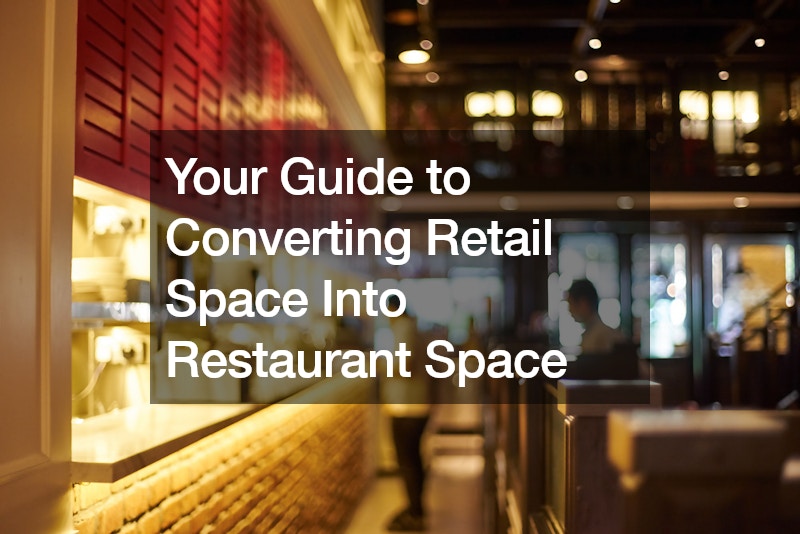
Your Guide to Converting Retail Space Into Restaurant Space
1. What are the key considerations for converting retail space into a restaurant?
Location Analysis

Converting retail space into restaurant space requires a thorough location analysis to ensure that the area is suitable for a food establishment. Factors such as foot traffic, visibility, and proximity to other businesses should be considered to maximize the restaurant’s potential for success.
Regulatory Requirements
Before converting retail space into restaurant space, it is crucial to understand and comply with all regulatory requirements. This includes obtaining permits for renovations, ensuring compliance with health and safety regulations, and obtaining a commercial waste removal service to properly dispose of restaurant waste.
Space Layout and Design
The layout and design of the restaurant space are essential considerations when converting retail space into restaurant space. It is important to create a functional layout that maximizes seating capacity while also providing an inviting atmosphere for customers. Hiring drywall contractors and contractors who use a custom moulder knife for unique designs can help achieve the desired aesthetic.
Business Insurance
Converting retail space into restaurant space also requires obtaining the right insurance coverage. A Christian insurance policy can help protect the restaurant from potential risks such as fire damage, liability claims, or property damage. It is essential to work with an insurance provider that understands the unique needs of restaurant businesses.
2. How can you determine if a retail space is suitable for a restaurant conversion?
Assessing Infrastructure

When considering a retail space for conversion into a restaurant, it is important to assess the existing infrastructure. This includes evaluating the electrical, plumbing, and HVAC systems to determine if they can support the needs of a restaurant. Working with local excavation contractors can help identify any potential issues and plan for necessary upgrades.
Evaluating Zoning Restrictions
Converting retail space into a restaurant also requires evaluating zoning restrictions in the area. It is important to ensure that the space is zoned for food service and that there are no restrictions that would prevent the operation of a restaurant in the location. Consulting with local authorities and zoning boards can provide valuable information.
Estimating Renovation Costs
Before converting retail space into restaurant space, it is essential to estimate renovation costs accurately. This includes budgeting for new kitchen equipment, furniture, decor, and hiring professionals such as drywall contractors. Renting a dumpster for renovations can help streamline the process and ensure that waste is properly disposed of.
3. What are the steps involved in converting retail space into restaurant space?
Obtaining Permits

The first step in converting retail space into restaurant space is obtaining the necessary permits. This includes permits for renovations, health and safety inspections, and zoning compliance. Working with a reputable contractor can help navigate the permit process and ensure that all requirements are met.
Creating a Floor Plan
Creating a functional floor plan is essential when converting retail space into restaurant space. This includes designing the layout of the dining area, kitchen, bar, and other essential spaces. Installing ABM panels for the roof can help improve insulation and energy efficiency in the restaurant space.
Installing Kitchen Equipment
Installing kitchen equipment is another crucial step in converting retail space into restaurant space. This includes purchasing and installing commercial-grade appliances, refrigeration units, custom moulder knifes, and food preparation stations. Working with reputable suppliers and contractors can ensure that the kitchen is equipped to meet the needs of the restaurant.
Investing in ABM Panels for Your Roof
ABM panels are a cost-effective and energy-efficient solution for restaurant roofing. They can help regulate the temperature in the restaurant space, reduce energy costs, and improve insulation. Investing in ABM panels for your roof can be a smart choice when converting retail space into a restaurant.
Rent a Dumpster for Your Renovations
Renting a dumpster for renovations is a convenient way to manage waste and debris during the conversion process. A commercial waste removal service can provide dumpsters of various sizes to accommodate the needs of the renovation project. Renting a dumpster can help keep the workspace clean and organized.
Hire an Excavator
Hiring an excavator may be necessary when converting retail space into restaurant space. Excavators can help clear the site, dig trenches for utilities, and level the ground for construction. Working with local excavation contractors can ensure that the excavation process is completed safely and efficiently.
Install New Drywall
Installing new drywall is a key step in renovating retail space into a restaurant. Drywall contractors can help repair any existing damage, create a clean finish, and enhance the overall aesthetic of the space. Custom moulder knife can be used to add unique details and architectural elements to the drywall.
4. How can you optimize the layout of a converted retail space for a restaurant?
Maximizing Seating Capacity

When converting retail space into a restaurant, maximizing seating capacity is essential to accommodate customers and increase revenue. This can be achieved by strategically placing tables, booths, and bar seating to make the most efficient use of the space. Investing in concrete walkways can help create a durable and aesthetically pleasing dining area.
Designing Functional Workstations
Designing functional workstations in the kitchen and serving areas is crucial for the efficiency of the restaurant operation. This includes creating designated spaces for food preparation, cooking, plating, and serving. Working with concrete contractors can help create durable and easy-to-clean surfaces for workstations.
Ensuring Proper Ventilation
Proper ventilation is essential in a restaurant to maintain air quality, regulate temperature, and remove cooking odors. Installing quality ventilation systems can help create a comfortable dining environment for customers and improve the overall experience. Double hung window installations can also enhance natural ventilation and lighting in the restaurant space.
Investing in Concrete Walkways
Concrete walkways are a durable and low-maintenance option for restaurant flooring. They can withstand heavy foot traffic, spills, and outdoor elements. Investing in concrete walkways can create a cohesive and functional dining area that is easy to clean and maintain.
Installing New Windows
Installing new windows in the restaurant space can improve natural lighting, ventilation, and energy efficiency. Double hung window installations are a popular choice for restaurants as they allow for easy operation and provide excellent ventilation. Adding windows can enhance the ambiance of the space and create a welcoming atmosphere for customers.
Add a Patio for Outdoor Seating
Adding a patio for outdoor seating can expand the dining space and attract more customers to the restaurant. Patios are a popular feature for restaurants as they provide a unique dining experience and can increase revenue. Working with a patio contractor can help design and create a functional outdoor dining area that complements the restaurant space.
5. What are the common challenges faced when converting retail space into a restaurant?
Dealing with Existing Fixtures
One common challenge when converting retail space into a restaurant is dealing with existing fixtures and layout restrictions. Retail spaces may have structural elements or fixtures that are not conducive to a restaurant layout. Adapting the space to accommodate kitchen equipment, seating, and other restaurant needs can be a complex process.
Navigating Health and Safety Regulations
Health and safety regulations are stringent in the restaurant industry, and navigating these regulations can be challenging when converting retail space. This includes ensuring proper ventilation, sanitation, and food storage facilities to meet health department requirements. Working with contractors who are familiar with health and safety standards can help ensure compliance.
Managing Noise Levels
Noise levels can be a significant challenge when converting retail space into a restaurant. Restaurants can generate a lot of noise from kitchen operations, customer conversations, and background music. Implementing soundproofing measures such as acoustic panels or ceiling treatments can help reduce noise levels and create a more comfortable dining environment.
6. How can you create a successful brand identity for a restaurant in a converted retail space?
Developing a Unique Concept
Creating a unique concept for the restaurant is essential to establish a strong brand identity. This can include developing a theme, menu, and overall ambiance that sets the restaurant apart from competitors. Investing in custom moulder knife for unique decor elements can help create a memorable and cohesive brand experience.
Designing an Inviting Ambiance
The ambiance of a restaurant plays a significant role in attracting customers and creating a memorable dining experience. Designing the space with elements such as lighting, decor, and seating arrangements can help create an inviting atmosphere. Utilizing secondhand equipment or repurposing existing furniture can also add character to the restaurant space.
Implementing Effective Marketing Strategies
Implementing effective marketing strategies is crucial for promoting the restaurant and attracting customers. This can include digital marketing, social media campaigns, and local advertising. Engaging with the local community and partnering with other businesses can also help increase brand awareness and customer loyalty.
7. What are some cost-effective ways to renovate a retail space into a restaurant?
Repurposing Existing Furniture
Repurposing existing furniture from the retail space can be a cost-effective way to furnish the restaurant. This can include painting, reupholstering, or modifying furniture to fit the new restaurant aesthetic. DIY painting and decorations can also help save on renovation costs and add a personal touch to the space.
DIY Painting and Decorations
DIY painting and decorations can significantly reduce renovation costs when converting retail space into a restaurant. This can include painting walls, installing wallpaper, or adding decorative elements such as artwork or signage. DIY projects can be a fun and creative way to personalize the restaurant space on a budget.
Utilizing Secondhand Equipment
Utilizing secondhand equipment for the restaurant kitchen can be a cost-effective solution for outfitting the space. This can include purchasing refurbished appliances, furniture, and kitchen tools at a lower cost. Working with reputable suppliers and contractors can help ensure that the equipment is in good condition and meets the restaurant’s needs.
Maintain your concrete parking area
Maintaining the concrete parking area is essential for the overall aesthetic and functionality of the restaurant space. This includes regular cleaning, sealing, and repairs to prevent damage and ensure safety for customers. Working with concrete contractors can help maintain the parking area and create a positive first impression for guests.
8. How can you ensure the success of a restaurant in a converted retail space?
Providing Quality Food and Service
One of the key factors in the success of a restaurant in a converted retail space is providing quality food and service. This includes sourcing fresh ingredients, creating a diverse menu, and training staff to deliver exceptional customer service. Consistency in food quality and service is essential for building a loyal customer base.
Engaging with the Local Community
Engaging with the local community is vital for the success of a restaurant in a converted retail space. This can include participating in community events, partnering with local businesses, and supporting charitable causes. Building relationships with customers and community members can help generate word-of-mouth referrals and repeat business.
Adapting to Customer Feedback
Adapting to customer feedback is essential for continuously improving the restaurant and meeting customer expectations. This can include soliciting feedback through surveys, reviews, and social media channels. Listening to customer comments and addressing concerns can help identify areas for improvement and enhance the overall dining experience.
9. What are the potential benefits of converting retail space into a restaurant?
Diversifying Revenue Streams
Converting retail space into a restaurant can diversify revenue streams for property owners and entrepreneurs. Restaurants have the potential to generate consistent income through food sales, catering services, and private events. This can help offset the seasonal or fluctuating nature of retail business revenue.
Utilizing Existing Infrastructure
Utilizing existing infrastructure in a retail space can help reduce renovation costs and accelerate the restaurant opening process. Retail spaces often have amenities such as electrical, plumbing, and HVAC systems that can be repurposed for restaurant use. This can streamline the renovation process and reduce the overall investment required.
Revitalizing Underutilized Areas
Converting retail space into a restaurant can revitalize underutilized areas and contribute to the economic growth of a community. Restaurants can attract foot traffic, create job opportunities, and stimulate local businesses. This can help reinvigorate the neighborhood and make the area more vibrant and desirable for residents and visitors.
10. How can you stay updated on trends and innovations in converting retail space into a restaurant?
Attending Industry Events and Workshops
Attending industry events and workshops can help stay updated on trends and innovations in converting retail space into a restaurant. This can provide valuable networking opportunities, access to industry experts, and insights into best practices. Learning from other professionals can help identify new ideas and strategies for success.
Networking with Industry Professionals
Networking with industry professionals in the restaurant and real estate sectors can help stay informed about trends and innovations. Building relationships with contractors, suppliers, and other professionals can provide valuable connections and resources for restaurant conversion projects. Sharing ideas and experiences with peers can also help generate new insights and opportunities.
Researching Online Resources and Publications
Researching online resources and publications dedicated to the restaurant industry can provide valuable information and insights into trends and innovations. This can include industry websites, blogs, and publications that cover topics such as restaurant design, renovation, and operations. Staying informed about current trends can help make informed decisions and stay ahead of the competition.
Conclusion
Converting retail space into a restaurant can be a rewarding and profitable venture with the right planning and execution. By considering key factors such as location analysis, regulatory requirements, space layout, and business insurance, entrepreneurs can successfully transform retail spaces into thriving food establishments. Assessing infrastructure, evaluating zoning restrictions, and estimating renovation costs are crucial steps in determining the suitability of a retail space for a restaurant conversion. By following the steps involved in the conversion process, optimizing the layout, and overcoming common challenges, individuals can create a successful brand identity and ensure the success of their restaurant. Utilizing cost-effective renovation strategies, providing quality food and service, and adapting to customer feedback can help drive the success of a restaurant in a converted retail space. Diversifying revenue streams, utilizing existing infrastructure, and revitalizing underutilized areas are among the potential benefits of converting retail space into a restaurant. By staying updated on trends and innovations through industry events, networking, and online resources, individuals can stay competitive and innovative in the restaurant industry.




